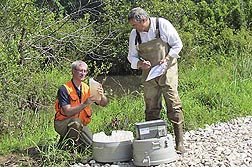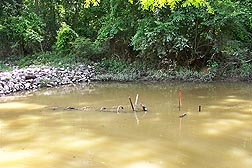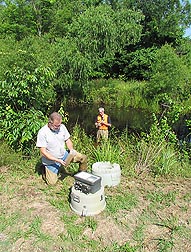Delta Backwaters Can Capture Field Runoff Pollutants
|
|
In the alluvial floodplain of the Mississippi Delta, sediment accumulation can cut off segments of meandering river channels from the main channel. These isolated segments eventually become the oxbow lakes and backwater wetlands that are scattered across the Delta landscape. Agricultural Research Service ecologist Richard Lizotte believes these oxbow lakes are more than just a fisherman’s retreat or an alligator’s lair; he thinks they help improve water quality by trapping and removing agricultural pollutants lost from adjacent croplands.
“In our region, we see nitrogen and pesticide losses in runoff from corn fields. These chemicals can have a big effect on downstream water bodies, including depleting oxygen in the waters of the Gulf of Mexico,” says Lizotte, who works in the ARS Water Quality and Ecology Research Unit in Oxford, Mississippi. “Farmers want to protect water quality, but when they set aside land for buffer zones to help keep chemicals and sediment out of nearby streams, they lose the profits that come from cultivating these lands.”
Putting a Wetland to Work
For almost a decade, Lizotte and others have been devising ways to use oxbow lakes and wetlands for cleaning up the runoff from crop fields. In his first study, Lizotte looked at how effectively an experimental wetland along Mississippi’s Coldwater River trapped atrazine, S-metolachlor, and fipronil, which are commonly used as crop pesticides. Retired ARS hydraulic engineer Doug Shields, ecologist Scott Knight, and biologist Charles Bryant collaborated with Lizotte on the research.
The study watershed was developed in a small stretch of the Coldwater River that had been cut off from the main channel, and the resulting water body had two distinct sections. One was as deep as a small lake, and the other was a shallow wetland surrounded by natural vegetation.
The team installed small dams called “weirs” at either end of the wetland. Then they added the three pesticides to the wetland at the upstream weir at rates that would simulate typical runoff rates from a 40-acre field. They collected water samples from the upstream weir every hour within the first 24 hours after simulating the runoff. They also collected samples near both weirs at increasingly longer intervals—from 2 days to 2 weeks—for the next 8 weeks.
Lizotte and his partners found that it only took 24 hours after they added the pesticide mix for pesticide concentrations near the upstream weir to drop almost 65 percent. A week later, pesticide concentrations at the upstream weir had dropped to 20 percent of their original amount, and 21 days later, they were undetectable.
The results at the downstream weir were even more striking. One day after the pesticides were added to the wetland, water near the downstream weir contained only trace amounts of the pesticides. Four weeks later, the pesticides were completely undetectable.
Upping the Expectations
Lizotte and Knight also assessed how well the same experimental wetland reduced concentrations of pesticides, nutrients, and sediment from a “catastrophic” runoff event. This could take the form of an unexpected storm that strikes shortly after fertilizers and/or pesticides are applied, even though farmers try their best to avoid these circumstances. “They watch weather reports a lot more closely than most people do,” Lizotte observes.
The scientists noted that sediment, phosphorus, nitrogen, and pesticide concentrations peaked within 3 hours after the event as far as 325 yards below the upstream weir. But within 48 hours, loads of the sediment, nutrients, and pesticides had been reduced by as much as 98 percent. At 28 days later, levels of all the pollutants had returned to—and sometimes even dropped below—pre-event levels.
“Our research indicates that these types of wetlands could become a very effective and efficient tool for reducing field runoff contaminants. By developing this technology, we don’t have to take any land out of production, since the wetlands are already part of the landscape,” says Lizotte. “But we’ll need to engineer their design and management to accommodate potential performance differences.”
The Delta region where this research was conducted is located within the Lower Mississippi River Basin, which is one of 18 regions participating in the ARS Long-Term Agro-ecosystem Research (LTAR) network. ARS scientists at the National Sedimentation Laboratory are leading the LTAR work in the Lower Mississippi River Basin.
Results from this research have been published in River Research and Applications, Science of the Total Environment, and Ecohydrology.—By Ann Perry, Agricultural Research Service Information Staff.
This research is part of Water Availability and Watershed Management, an ARS national program (#211) described at www.nps.ars.usda.gov.
Richard Lizotte is with the USDA-ARS Water Quality and Ecology Research Unit, National Sedimentation Laboratory, 598 McElroy Dr., Oxford, MS 38655; (662) 281-5703.
The fertile alluvial soils of the Mississippi Delta have been built up by repeated cycles of seasonal flooding, but current floodplain management often restricts flooding in agricultural and urban areas. Although there are many benefits to this management, it also disrupts ecosystems that have evolved in response to regular flooding, and it reduces the supply of water that helps sustain water quality in oxbow lakes and wetlands.
Agricultural Research Service scientists Richard Lizotte, Scott Knight, and Sam Testa explored ways of protecting these environments by comparing water quality in an oxbow lake before, during, and after artificial flooding in the late summer.
For 30 days, they pumped water from the Coldwater River into the lake, where significant improvements in water quality started almost immediately. These included lower sediment and nutrient loads and fewer swings in water temperature, dissolved oxygen levels, and pH levels. Average lake depth increased from 19 inches to 30 inches, which gave the lake—and its residents—an extra cushion of protection during drought interludes. Overall, the team concluded that artificial flooding could be used by natural-resource managers to stabilize water quality and improve habitat for fish and aquatic invertebrates.
"Delta Backwaters Can Capture Field Runoff Pollutants" was published in the September 2014 issue of Agricultural Research magazine.









